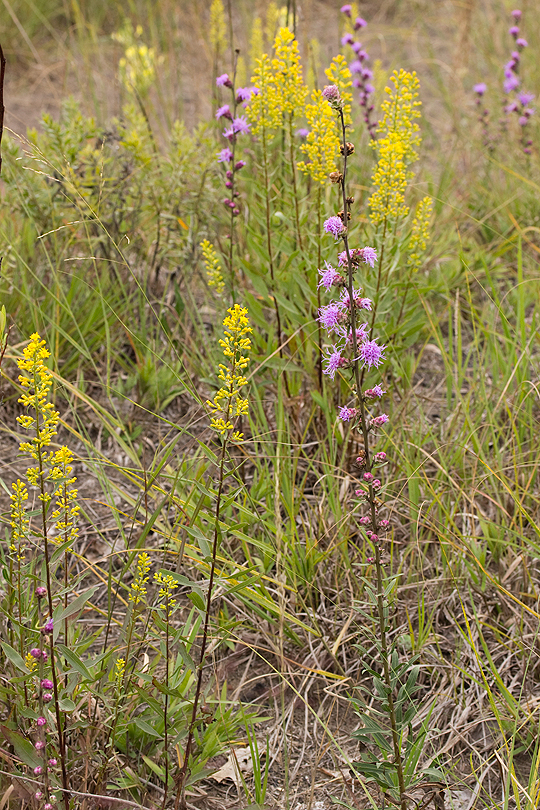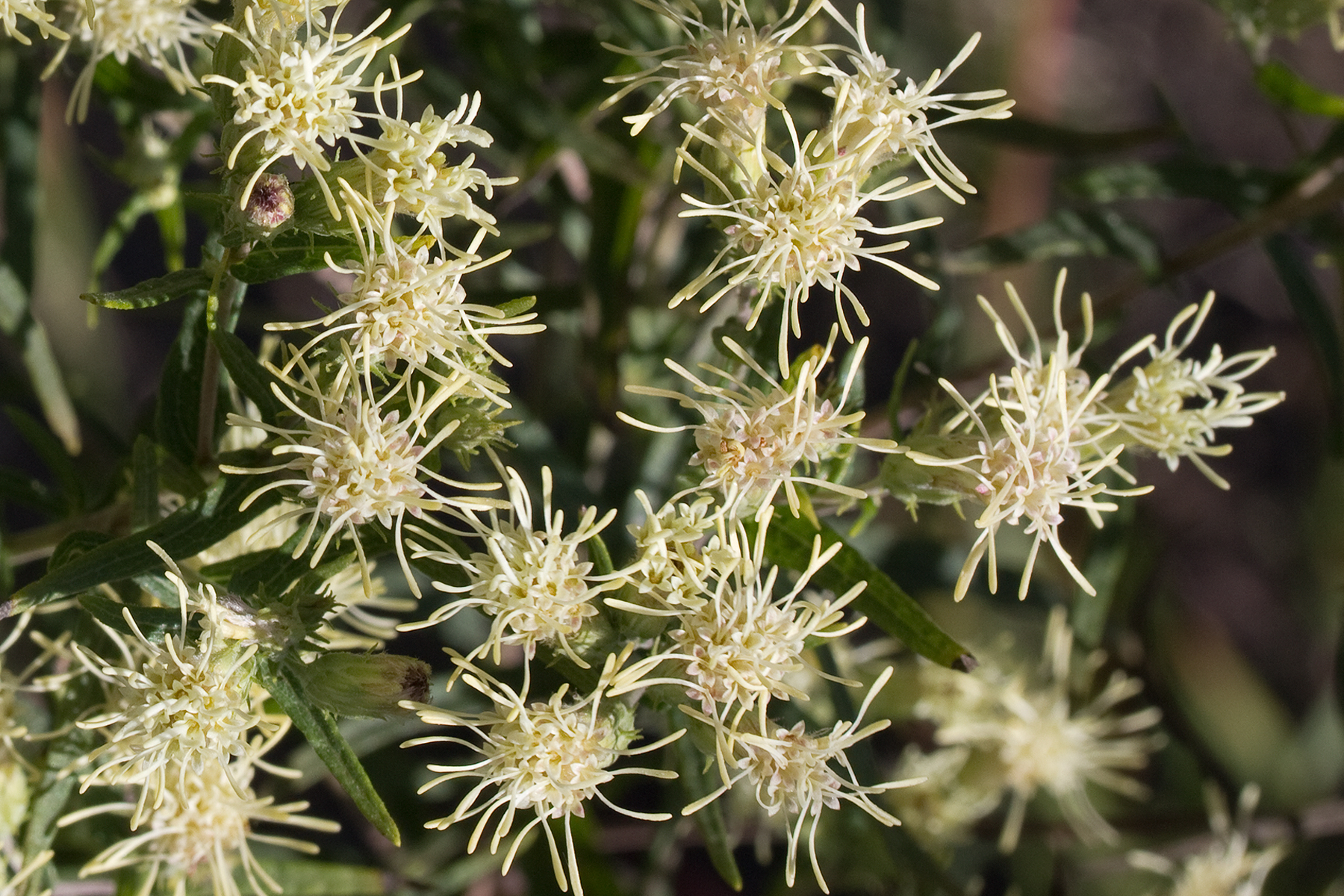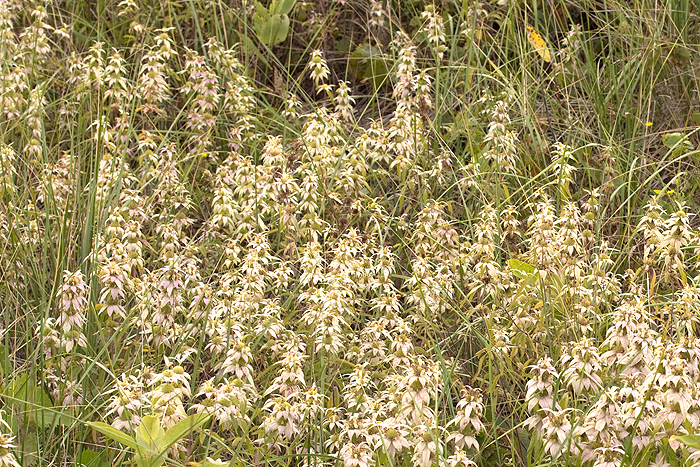Growing a wildlife garden on sunny dry sand.
You might be forgiven for thinking that sandy soil is a terrible medium in which to grow plants in. It is true that if you want to grow vegetables, you are going to need to build a raised bed, but there is a surprisingly diverse range of beautiful plants that are well adapted to growing in sandy soil without the need for irrigation.
| |
 |
|
| |
Here, Liatris aspera and Solidago gillmanii are growing together on a dry sandy prairie. |
|
Sand is a relatively large particle that will have large spaces. Sandy soils therefore have a high proportion of macropores that promote drainage, but not enough micropores to promote water retention. The lack of water retention is a limiting factor that prevents most plants from growing in this medium. The lack of clay particles in a sandy soil results in a low ability to bind to essential mineral ions so plants also have to be able to tolerate a lack of nutrients as well. Sand has a lower heat capacity than other soils so it heats up and cools down more quickly. The plants have to be able to handle the daily temperature changes as well as the seasonal changes that come with cold winters and hot dry summers. In their natural habitat these plants would also need adaptations to survive fire and grazing.
Over long periods of time (let's say thousands of years), a dark rich topsoil can develop over a layer of sand leading to a climax community called mesophytic forest. These forests may contain basswood but the trees that complete the process of succession are American beech and Sugar maple. These forests are not subject to the same ecological factors that allow sandy prairies to form and the plants that live there cannot survive drought. Therefore, they are not included in the list of plants on this page. Since developers often remove the topsoil in such forests when building houses, you may have to use this list to plant in the sandy soil that remains.
If you do not intend to water, then choose plants that survive well in sand dunes, dry sandy prairies and open sandy savanna.
| |
 |
|
| |
A dry sandy prairie with some savanna in the background. |
|
All of the following plants do well in relatively undeveloped sandy soils. However, you should be prepared to water in times of drought for the first couple of years to ensure success. During this time, many of these plants are growing roots deep into the ground, which allows them to survive the dry periods. When it does rain these plants often have root systems that enable them to quickly absorb water before it drains away. Other strategies to survive include leaves that are: narrow or indented; hairy; thick and waxy; and being succulent. Most temperate plants use a photosynthesis mechanism called C3 which is an efficient process at low temperatures with adequate moisture. In sandy prairies and other similar habitats, there is a much higher proportion of plants that use a more complicated photosynthetic pathway known as C4 because it is more energy efficient at high temperatures and reduces the loss of water. Warm season grasses such as Indian Grass and Big Blue Stem use the C4 mechanism for photosynthesis.
It is important not to dig around too much in a sandy soil because this will disturb the fungal hyphae that forms an intricate part of the soil. These hyphae interact with plants and bacteria. They obtain carbon from the plants but they also help many plants to obtain vital nutrients and water. They help plants to protect themselves against the effects of drought. They also help soils retain water for longer when it rains and they help to aggregate the soils.
I was asked to design a garden on a strip of land between two houses which would require no watering and minimal weeding. The soil was undeveloped and almost pure sand. To reduce weeding the vegetative cover had to be 100 %. Some watering had to be done in the first year as roots need time to grow, but in its third year all the plants can survive on their own two feet. I chose only plants that would grow in a dry sandy prairie and 50 % of the cover is grass.
| |
 |
|
| |
A dry sandy garden in its third year. The main flowers are butterfly weed, but Gaillardia is used to fill in the spaces. Grasses include Bouteloua curtipendula and Sporobolus heterolepis. The garden is now a magnet for monarch butterflies and many other pollinators. |
|
Grasses and sedges
Forbs for the front of the border
| Name |
Notes |
Amorpha canescens  |
A small leguminous plant that attracts pollinators. |
Anemone cylindrica  |
A short anemone for the front of the border. |
Antennaria neglecta  |
A groundcover that is a host of painted ladies. |
Asclepias sp.  |
A. ovalifolia and A. verticillata are the shortest of the milkweeds. |
Baptisia sp.  |
Ontario native B. tinctoria and also B. bracteata handle dry soils well. |
| Corydalis aurea |
Of low use to wildlife, but it is a small ornamental plant. |
Dalea sp.  |
D. candida and D. purpurea are good for sandy soil. D. purpurea with its electric purple flowers is more popular. |
Geum triflorum  |
Forms a low living mulch and has purple flowers. |
Liatris cylindracea  |
If a monarch butterfly finds this plant, it will dwell for a while. |
Lithospermum sp.  |
L. canescens and L. carolinese. These plants have beautiful flowers but they are almost impossible to cultivate from seed and therefore hard to obtain. However, if plugs and not seeds were to become available, you should consider planting them. |
Oligoneuron album  |
This is another name for Solidago ptarmicoides. |
Opuntia humifusa  |
This is a very specialised plant that needs careful consideration before planting in a garden. The flowers are stunning. |
Penstemon sp.  |
P. hirsutus and P. pallidus are shorter Penstemons that handle dry soil very well. |
Phlox pilosa  |
Extirpated from Ontario, this early flowering phlox attracts butterflies and maybe hummingbirds. |
Physalis heterophyla  |
Spreads easily. Give it plenty of room. |
Pulsatilla patens  |
The prairie crocus is a superior garden plant to the store-bought Crocus. |
Ranunculus fascicularis  |
An early flowering buttercup. |
Ruellia humilis  |
This low growing plant is native to the mid-west and E. America. |
Solidago sp.  |
S. ptarmicoides and S. nemoralis are short goldenrods in the drylands. S. ptarmicoides looks more like an aster with large blooms of white flowers. |
Tephrosia virginica  |
A shorter leguminous perennial with bicoloured flower that does well in acidic sandy soil. |
| |
|
Forbs for the middle of the border
| Name |
Notes |
Asclepias sp.  |
A. ovalifolia, A. tuberosa, A. verticillata and A. viridiflora |
| |
 |
|
| |
In a dryland garden, butterfly weed puts on a fantastic show. This is a single specimen. |
|
|
| Baptisia leucantha (B. alba) |
A near native for Ontario and host to the Indigo duskywing. |
| Brickellia eupatorioides |
Not native to Canada, but widespread in the U.S. |
Castilleja coccinea  |
Annual with red flowers that attract hummingbirds. It is hemiparasitic on grasses and a few other species. |
Cirsium sp.  |
C. discolor is not the only thistle to grow well in sand, but the other thistles require a lot of waiting for flowers to appear. C. discolor only needs two years to mature. |
Coreopsis lanceolata  |
An easy to grow plant that is popular with gardeners. |
| |
 |
|
| |
Brickellia eupatorioides grows in most states that are East of the Rockies. It is not native to Canada
|
|
|
Drymocallis arguta  |
Has sulphur yellow flowers. |
Echinacea pallida  |
Not the typical purple coneflower found in gardens, but this species is very drought and sand tolerant. |
Euphorbia corollata  |
This plant has a heavy bloom and is good for filling in spaces. |
Gaillardia pulchella  |
Beautiful annual plant. |
Helianthus sp.  |
H. divaricatus, H. occidentalis and H. petiolaris grow well in sand. |
Liatris sp.  |
L. aspera and L. scariosa are typical plants in the drylands. These plants produce stunning flowerheads. |
Lupinus perennis  |
This plant will not grow in clay, so if you have sand then take the opportunity to plant native lupines. They have stunning blooms. |
| |
 |
|
| |
Monarda punctata - Dotted beebalm. |
|
|
Monarda sp.  |
M. fistulosa and M. punctata are the best species. Monarda in bloom always looks spectacular when growing en masse. |
| Oenothera rhombipetala |
Not native to Canada, but you might consider this if you live in the mid-west. |
Penstemon grandiflorus  |
P. grandiflorus is from the mid-west. It flowers at the same time as other native Penstemons. |
Rudbeckia hirta  |
In sandy soil, it is biennial. It spreads by reseeding. |
Solidago sp. |
S. speciosa and S. juncea. |
Symphyotrichum sp.  |
S. laeve, S. oolengtangiense, S. ericoides and S. sericeum |
Tradescantia ohiensis  |
It spreads by rhizomes so it is well suited for naturalised areas on sandy soil. |
Verbena stricta  |
This is most drought tolerant of the species featured. |
Forbs for the back of the border (more than 4 feet high)
| Name |
Notes |
| |
 |
|
| |
Cirsium pitcheri is rare because it grows on relatively unstable dunes. Like other thistles, it is monocarpic. It grows for 5 - 8 years, produces a flower, and then dies. On foredunes, shifting sands would prevent the seeds of many other plants from germinating. Unfortunately, monocarpic flowers are not popular when you have to wait so long for the bloom. |
|
|
Cirsium sp.  |
C. discolor is not the only thistle to grow well in sand, but the other thistles require a lot of waiting for flowers to appear. C. discolor only needs two years to mature. |
Helianthus sp.  |
Helianthus mollis grows up to six feet tall in dry sand. |
Lespedeza sp.  |
L. capitata and L. hirta have flowers that are rather inconspicuous, but they do have foliage that remains green throughout the summer. They grow up to 5 feet. |
| |
 |
|
| |
Silphium integrifolium |
|
|
Oligoneuron sp.  |
O. rigidum is a good choice for a back of the border plant. It grows about 5 feet high. |
| Silphium integrifolium |
A reasonably drought tolerant Rosinweed that is often found on sandy soil. Silphium laciniatum also grows in dry soils. Both S. laciniatum and S. terebinthinaceum are drought resistant but may need a little bit of help to get to maturity. |
Solidago speciosa |
Solidago speciosa is typically shorter on dunes and in dry prairies, but in a garden they can reach 5 feet high. In my garden, they are back of the border plants. It is considered by many to the be the most beautiful goldenrod so it is a must have in a dry, sunny and sandy garden. |
Shrubs and vines



